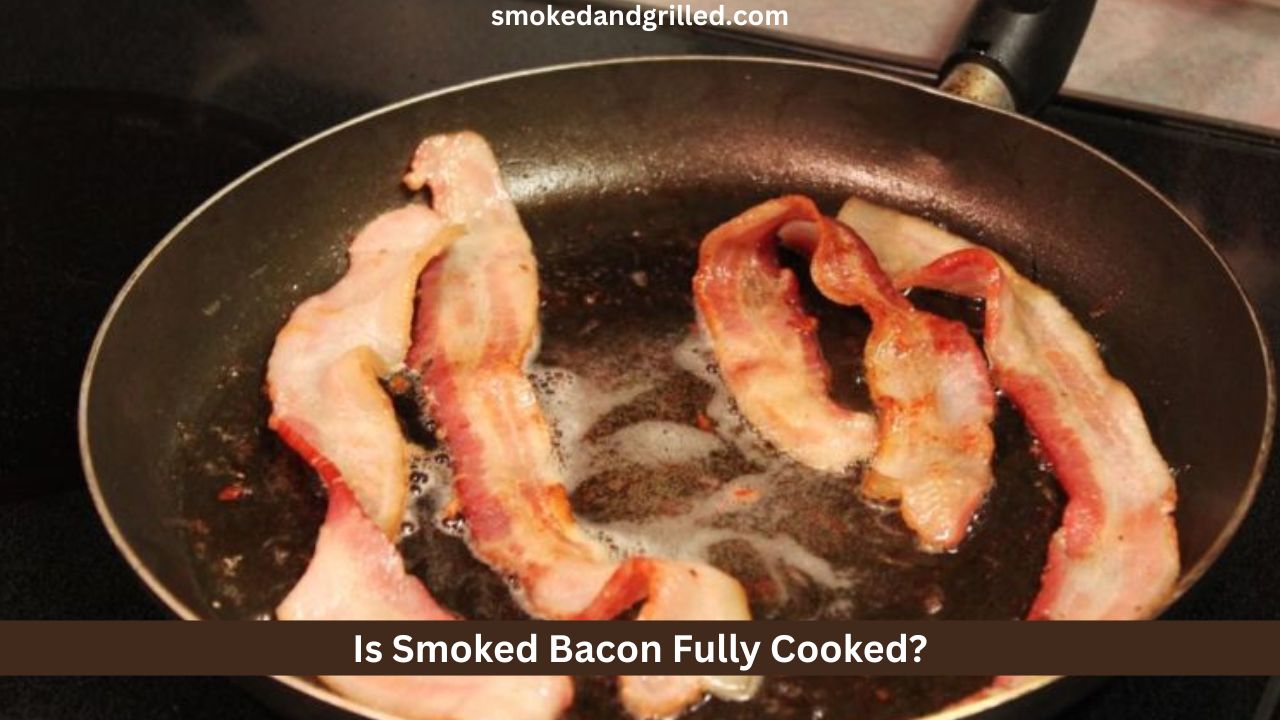Crispy, smoky, and oh-so-delicious – when you think of bacon, it’s hard not to start salivating.
The curing and smoking processes that bacon undergoes don’t always result in a well-cooked product because they only take a short amount of time at a low temperature. Bacteria can cause food illness.
Thus,, cooking bacon is a must. In this blog post, we’ll take an in-depth look at the difference between cooked and uncooked bacon and explain why it’s important for consumers to understand.
So grab a snack (or two!), and let’s dive into this tantalizing topic!
Does Smoked Bacon Need to be Cooked?
Is it safe to consume smoked bacon without first cooking it?
It’s a question that really has perplexed many bacon enthusiasts over the years.
The answer, to put it simply, is that it depends on which kind of bacon you are eating and how long it has been smoked.
Bacon that is labeled ready-to-eat or shelf-stable can be eaten cold as long as it is produced properly and stored correctly.
On the other hand, precooked bacon must be cooked before consumption as this type of bacon can spoil very quickly if not stored at or below 40°F.
As a result, if you’re not sure whether your delicious slice of bacon is precooked, always play it safe and cook it first!
How Is Bacon Smoked But Not Cooked?
This is because the process of smoking does not actually “cook” the bacon in the traditional sense.
Smoking refers to a method of curing meats, which involves exposing cuts of meat to smoke and slow heat to break down proteins and keep them from spoiling while also preserving their flavor.
Furthermore, fully cooked smoked bacon may still contain harmful bacteria like salmonella if temperatures are too low for long enough periods of time throughout the smoking process.
For these reasons, smoked bacon should still be treated as an uncooked product and cooked properly before consumption for maximum safety and enjoyment.
Can You Eat Raw Smoked Bacon?
Eating raw smoked bacon carries potential risks, such as salmonella and parasites, which can cause food poisoning; however, if prepared and stored properly, it is possible to safely eat raw smoked bacon.
When purchasing smoked bacon in its raw form, it is important to purchase only the highest quality product from a reputable retailer.
To prevent contamination during storage, always keep raw smoked bacon refrigerated and separate from other items in the refrigerator.
Before eating raw smoked bacon, carefully cook it until it reaches an internal temperature of at least 145 degrees Fahrenheit or 63 degrees Celsius in order to make sure any bacteria are killed.
This process not only kills harmful bacteria but also makes the meat easier to slice thinly for use in recipes such as salads or appetizers that utilize thin slices of cooked, diced, or crumbled bacon pieces.
How Is Bacon Smoked?
1- Wet Brine
The first step in smoking bacon is to wet brine the pork belly. This involves submerging the pork belly in a saltwater solution for a period of time, typically 12-24 hours.
This helps to add flavor and moisture to the meat.
2- Dry Rub
After the pork belly has been brined, a dry rub is applied. The dry rub is typically made up of sugar, salt, and spices such as paprika, black pepper, and cumin.
This helps to add flavor and color to the bacon.
3- Smoking
Once the pork belly has been brined and rubbed, it is ready to be smoked.
Bacon is typically smoked at a low temperature for a short period of time, typically 30 minutes.
This allows the smoke to penetrate the meat and add flavor.
4- Cooling
After smoking, the bacon is cooled to room temperature.
This helps to stop the cooking process and prevent the bacon from overcooking.
5- Slicing
Once cooled, the bacon is sliced into thin strips.
The thickness of the bacon strips will vary depending on preference.
6- Cooking
The final step is to cook the bacon strips.
This can be done by pan frying, grilling, or baking. Bacon is typically cooked until it is crisp and golden brown in color.
7- Serving
Bacon can be served on its own or used as an ingredient in other dishes such as eggs, sandwiches, salads, and pasta dishes.
Cold VS Hot Smoking
To put it another way, cold smoking does not finish cooking the meat; it merely adds flavor and helps to preserve it.
While cold smoking should not reach temperatures higher than 86 degrees Fahrenheit, hot smoking can reach up to 176 degrees Fahrenheit.
Modern Bacon Preparation Methods
The thoroughly cured bacon that was commonplace in homes before the invention of the refrigerator cannot be compared to the mass-produced bacon that is sold in stores today.
- The belly is removed from the carcass before the belly is used to make bacon.
- The cut is then opened up, and the skin is separated from it.
- When the meat is brined, it is treated with a solution that is made up of salts, sodium nitrates, and occasionally other compounds. This solution is used to cure the meat.
- To provide a smoky flavor to the bacon, liquid smoke is mixed into the brine before it is applied.
- After that, the bacon is either given injections of the brine or let to soak in it. Most of it was injected.
- They smoke the bacon in order to give it a deeper flavor and darker color. The bacon will only be partially cooked as a result of this.
Which Bacon Can You Safely Eat Without Cooking?
Bacon is a culinary favorite, but it must be cooked properly in order to render it safe for consumption.
It’s possible to buy precooked bacon to avoid the content of sizzling up your own recipe – but some say there’s no replacing the flavor of freshly made homemade bacon.
If you do go the pre-prepared route, make sure you store it in a resealable bag so that you may refrigerate it.
As for heating your bacon? A light zap in the microwave for at least 15 seconds should do the trick, ensuring crispy or soft bites without harming nutritional value.
Don’t forget that whatever packaged bacon you purchase won’t remain certified as safe after 14 days from opening it up if left unsealed!
Is Smoked Bacon Healthier?
The smoking procedure does not significantly improve the safety of eating smoked bacon in comparison to unsmoked bacon.
Whether it is smoked or not, bacon is an excellent source of protein of high quality, as well as the vitamins B1, B2, B3, B5, B6, and B12, as well as the minerals selenium, phosphorus, iron, magnesium, zinc, and potassium.
Can You Undercook Bacon?
Bacon can be undercooked, although it’s quite difficult to do so because of how quickly it cooks.
Due to the fact that bacon is so thin, it only needs a few minutes to be completely cooked in a frying pan.
When you cook thick pieces, the possibility of their having a raw center increases. Therefore, simply add a couple of additional minutes to the total cooking time.
Raw pork can be hazardous to your health, but since bacon goes through a curing process that involves salt, it is safer to consume raw bacon than other hog cuts that aren’t cured.
How Do You Know When Bacon Is Fully Cooked?
The cooking time for bacon is simply a few minutes. Fry the bacon strips in their own grease for one to two minutes on each side.
This will produce soft bacon. This should cause them to turn a golden brown color, indicating that the food is ready to be consumed.
Fry the bacon for two to three minutes on each side, and keep an eye out for foamy bubbles to form on the surface of the bacon.
Why Can You Eat Raw Ham But Not Bacon?
While you may think of bacon and ham as being cut from the same piece of pig, in reality, there are several key differences between them.
The curing process kills bacteria that may be present in the meat, making it much safer to consume without cooking first.
Bacon, on the other hand, doesn’t have this preservation layer since it is intended to be cooked before it is eaten.
Therefore, it wouldn’t be safe to consume raw bacon as it could contain harmful microbes like salmonella and E. coli that could cause food poisoning if ingested.
Additionally, both types of meat should still always be kept refrigerated until right before use so that any potential bacteria that survived the curing process remain dormant.
Can You Eat Smoked Bacon When Pregnant?
Pregnant women often have an array of dietary restrictions to manage, and it can be difficult to decide which foods are safe to eat.
Among the list of items in question is smoked bacon. Fortunately for expectant mothers, research has found that consuming small amounts of food is considered safe.
It may contain harmful bacteria like listeria if not properly handled and stored.
It is important for pregnant women to pay attention to both how much of this type of bacon they are eating as well as where it is coming from in order to reduce their risk for potential health challenges for themselves as well as their unborn child.
How long does it take to cook smoked bacon?
Cooking smoked bacon can seem intimidating, but it doesn’t have to be. It’s actually an incredibly simple task that will leave your taste buds delighting in the aroma.
The key is to cook the bacon low and slow.
Letting the bacon cook without flipping or turning will ensure that both sides are evenly cooked so you don’t end up with one side crispy and the other side greasy.
And when 30 minutes have passed, you’ll be sure to have some delicious smoked bacon ready to enjoy!
Can you smoke bacon without curing it?
The use of smoke or the application of salt can be utilized to preserve meals at home.
However, a mixture of salt, sugar, and various additional flavors produces a more appetizing flavor.
To use a technical term, “cured bacon” refers to any sort of preserved bacon.
There is no such thing as uncured bacon because all bacon is cured in some way, either through the use of smoke or salt.
Conclusion
Unfortunately, most smoked bacon is still too raw to be eaten. Because of the curing and smoking processes, bacon only gets partially cooked.
There is an increased chance of becoming sick from eating raw bacon. In order to ensure that your bacon is cooked properly, please refer to the package directions.
The smoke kills some of the bacteria in the meat and also lightly cooks it, so smoked bacon keeps for a longer period of time in the fridge.
Bacon is ready in a matter of minutes.
Three minutes is all it takes to fry up some soft bacon, and six minutes is about right for making some crispy bacon.
When it turns a darker brown color, you know it’s done cooking. The Maillard reaction describes this phenomenon.
More time is spent smoking and curing ham and other precooked meats than bacon.




